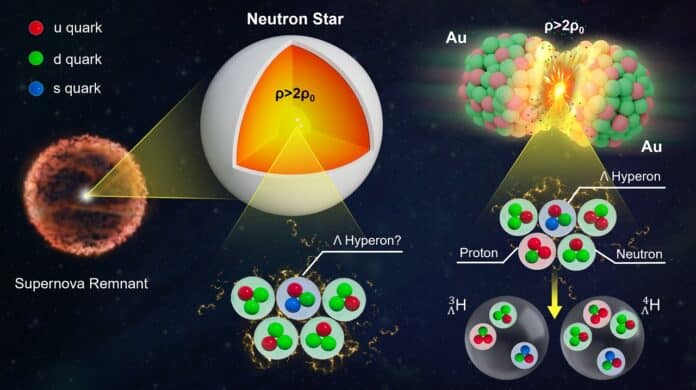The first observation of directed hypernuclei flow was made by physicists working at the Relativistic Heavy Ion Collider (RHIC), where they are researching particle collisions. At least one “hyperon” is present in these short-lived, uncommon nuclei in addition to regular protons and neutrons.
Compared to regular nucleons, hyperons have at least one “strange” quark instead of an up or down quark.
Among the universe’s densest and most exotic phenomena, Neutron stars are thought to contain large amounts of this particular substance in their centers.
Particle collisions can provide scientists with information on these celestial objects from a laboratory right here on Earth, even though traveling to neutron stars to examine this exotic matter is still the stuff of science fiction.
Xin Dong, a physicist from the U.S. Department of Energy’s Lawrence Berkeley National Laboratory (LBNL) who was involved in the study, said, “The conditions in a neutron star may still be far from what we reach at this moment in the laboratory, but at this stage, it’s the closest we can get, By comparing our data from this laboratory environment to our theories, we can try to infer what happens in the neutron star.”
The researchers examined the flow patterns of the debris produced by collisions of gold nuclei using the STAR detector at RHIC. The massive pressure gradients produced by the collisions set off those patterns. They sought to learn more about how the hyperons and nucleons interact.
Yapeng Zhang, another member of STAR from the Institute of Modern Physics of the Chinese Academy of Sciences, who led the data analysis with his student Chenlu Hu, said, “In our normal world, nucleon-nucleon interactions form normal atomic nuclei. But when we move into a neutron star, hyperon-nucleon interactions—which we don’t know much about yet—become very relevant to understanding the structure.”
Scientists should get insight into the hyperon-nucleon interactions that produce these unusual particles by monitoring the flow of hypernuclei.
The observations, published in Physical Review Letters, will give theorists quantitative data to improve their models of the hyperon-nucleon interactions responsible for creating hypernuclei and the massive structure of neutron stars.
Zhang said, “There are no solid calculations to establish these hyperon-nucleon interactions; this measurement may constrain theories and provide a variable input for the calculations.”
Previous research has demonstrated that the flow patterns of normal nuclei often scale with mass, i.e., the more protons and neutrons a nucleus has, the more it exhibits collective flow in a given direction.
This shows that the protons and neutrons that make up these nuclei acquire their flow through their interactions, which the strong nuclear force controls.
The STAR results presented in this study demonstrate that hypernuclei have the same mass-scaling behavior, indicating that they are most likely formed using the same process.
They learn about the interaction of the nucleons via the coalescence mechanism, which is controlled by the strong nuclear force.
The scientists suggest that the observation of comparable flow patterns and the mass scaling relationship for both normal and hypernuclei indicates that the interactions between nucleons and hyperons are quite similar.
The flow patterns also reveal details about the matter produced by particle collisions, such as its temperature, density, and other characteristics.
“The pressure gradient created in the collision will induce some asymmetry in the outgoing particle direction. So, what we observe, the flow, reflects how the pressure gradient is created inside the nuclear matter.” Zhang said.
He also said, “The measured flow of hypernuclei may open a new door to study hyperon-nucleon interactions under finite pressure at high baryon density.”
To learn more about the medium’s features, the scientists will collect additional measurements of how hypernuclei interact with it.
This research would not have been possible without RHIC’s ability to operate over such a wide range of impact energies. The measurements were taken during Phase I of the RHIC Beam Energy Scan, a systematic examination of gold-gold collisions spanning from 200 GeV per colliding particle pair down to 3 GeV.
RHIC used “fixed-target” mode to achieve the lowest energy: One gold ion beam moving around the 2.4-mile-circumference RHIC collider collided with a gold foil inside the STAR detector. Because of the low power, scientists can obtain the maximum “baryon density,” a measure related to the pressure generated in collisions.
Yue-Hang Leung, a postdoctoral fellow from the University of Heidelberg, Germany, said, “At this lowest collision energy, where the matter created in the collision is very dense, nuclei and hypernuclei are produced more abundantly than at higher collision energies, The low-energy collisions are the only ones that produce enough of these particles to give us the statistics we need to do the analysis. Nobody else has ever done this before.”
What did the scientists learn at RHIC have to do with neutron stars? The fact that hypernuclei appear to form via coalescence in the same way that conventional nuclei do suggests that they, too, are formed at a late stage in the collision system’s evolution.
The researcher said, “At this late stage, the density for the hyperon-nucleon interaction we see is not that high.”
Dong said. “So, these experiments may not be directly simulating the environment of a neutron star.”
He added, “This data is fresh. We need our theory friends to weigh in. And they need to include this new data on hyperon-nucleon interactions when they build a new neutron star model. We need both experimentalists and our theorists’ efforts to work towards understanding this data and making those connections.”
This research was funded by the DOE Office of Science (NP), the U.S. National Science Foundation.
Journal Reference:
- B.E. Aboona et al. Observation of Directed Flow of Hypernuclei 3ΛH and 4ΛH in √sNN=3 GeV Au+Au Collisions at RHIC. Physical Review letter. DOI:10.1103/PhysRevLett.130.212301
